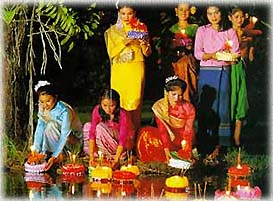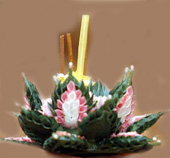Loi Krathong
Next>>Page 2
When the tide is high and rivers brim on the full moon in November, Thais pay tribute to water. Held this year on November 5, the Loi Krathong festival sees most of the population head to canals, streams or rivers like the Ping or Chao Phraya to bless this element so central to their culture, and to seek forgiveness for using and polluting it in the process. Thais say this thank you with flowers. Only we don’t present bunches or even garlands; we fit the plants architecturally into krathong — elaborate natural rafts that they construct from materials found in the traditional Thai garden or field. Most urbanites, however, buy ready-made krathong from pierside stalls.
What is a Krathong?

Unlike offerings to altar, vehicle or shrine, a krathong needs to loi (float), so they’re made of nature’s Styrofoam: slices of yuak gluay (banana trunk). Environmentalists and traditionalists have fought recent attempts to substitute plastic Styrofoam, and have largely kept the festivities green. In a contemporary compromise, inventive souls now bake multi-colour dyed bread krathong to subsequently feed the fish and turtles, though the crust makes it hard to pierce with pins or flower stems. Two-inch slices of yuak kluay provide better buoyancy and fibrousness for attaching the decoration, which is suffused with auspicious meaning. This miniature vessel embodies many levels of Thai arts and beliefs, helping to keep the craft skills alive.
Leaf origami
This time of year, the country’s banana trees get shorn of their most pristine leaves (bai tong). Over a meter long, they are de-spined and spliced into square sections suitable for cutting out to wrap the float and to fold into shapes derived from lai thai — the intricate patterns that form a symbolic language seen throughout temples, palaces and traditional arts.
Around the edge, nimble fingers are required to pleat blades of tang maprao (coconut leaves) into boxy geometric protrusions that come to resemble an open lotus pad. Bamboo pins keep the origami under tension in case it springs undone.
On top rises a lotus bud shaped spire built of bai tong. At its core, a chedi (stupa) shaped cone of leaf typically contains cooked sticky rice. The rice not only symbolises a staple derived from aquaculture, but its broad-based weight steadies the raft and its glutenous mass secures the myriad pins attaching the pointed side decorations. Called jeeb krathong (splayed leaves), the decorations evoke the jeeb finger gesture intrinsic to Thai dance. Tipped with dok phud (white jasmine buds), these sprays of twisted banana leaf also get dubbed nom maew from their resemblance to cat’s nipples.
On board the raft you find various lucky flowers, though none with negative connotations like lan thom (frangipani), which sounds like the term for sorrow. Dok bua (lotus buds) are most prevalent, along with yellow dao reuang (chrysanthmum), red dok kulaab (rose) and baan mai rue roy (globe amaranth), a bristly, non-wilting bloom that comes in white or purple. Orchids — sometimes dyed with even brighter hues than nature intended — are increasingly common stow-aways.
Completing the offering are the requisite candle and triple sticks of incense of Buddhist worship. Since the idea has arisen that you can wash your troubles away on launching your krathong, many Thais place a tiny piece of themselves — such as a hair or nail clipping — into the craft, along with a coin for good fortune.



No comments:
Post a Comment